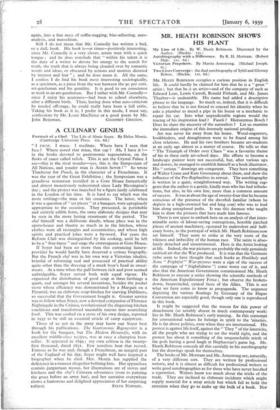A CULINARY GENIUS
Portrait of a Chef. The Life of Alexis Soyer. By Helen Morris. (Cambridge University Press. rm. 6d.)
" I PAUSE. I muse. I meditate. Where have I seen that face ? Where noted that mien, that cap ? Ah, I have it !- in the books devoted to gastronomic regeneration, on the flasks of sauce called relish. This is not the Crystal Palace I see—this is the rival wonder—yes, this is the Symposium of All Nations, and yonder man is ALEXIS SOYER ! " So wrote Thackeray for Punch, in the character of a Frenchman. It was the year of the Great Exhibition ; the Symposium was a grandiose restaurant installed in a Gore House fantastically and almost monstrously redecorated since Lady Blessington's day ; and the project was launched by a figure justly celebrated in the London of his time. It is hard, to say which was the more striking—the man or his creations. The latter, when it was a question of " set pieces " at a banquet, were egregiously appropriate to the occasion. They presented; in perishable and entirely edible form, the same elaborate designs that may be seen in the more lasting ornaments of the period. The chef himself was a deliberate dandy, whose place was in the opera-house and theatre as much as in the kitchen, whose clothes were all rectangles and eccentricities, and whose high spirits and practical jokes were a by-word. For years the Reform Club was distinguished by his cooking, until he left to be a " free-lance " and stage the extravaganza at Gore House.
If Soyer had been no more than this entrancing luxury- provider he would hardly have deserved a serious biography. But the French chef was in his own way a Victorian idealist, brimful of reforming zeal and possessed of practical ability quite other than the dressing of a mock boar's head in sweet- meats. At a time when the gulf between rich and poor seemed unbridgeable, Soyer served both with equal vigour. He organised the distribution of good soup at three farthings a quart, and amongst his several inventions, besides the pocket stove whose efficiency was demonstrated by a Marquis on a Pyramid, was an elaborate soup-kitchen for starving Dubliners, so successful that the Government bought it. Greater service was to follow when Soyer, now a devoted companion of Florence Nightingale in the Crimea, revolutionised the disgusting kitchen conditions and transformed uneatable rations into nourishing food. This was cooked on a stove of his own design, reported in 1935 to be still an essential article of camp equipment.
Those of us not in the army may know our Soyer best through his publications. The Gastronomic Regenerator is a book for the banquet, but The Modern Housewife, with its excellent middle-class recipes, was at once a champion best- seller. It appeared in 1849 ; my own edition is the twenty- first thousand, dated 1851. Few novelists beat that record. Famous as he was and, though a Frenchman, an integral part of the England of his day, Soyer might well have inspired a biographer when he died. Mrs. Morris has supplied the deficiency in a manner altogether befitting him. Her appendices contain gargantuan menus, her illustrations are of stoves and kitchens and the chef's Crimean adventures (even to painting the grass before an army hut), and her narrative everywhere shows a humorous and delighted appreciation of her surprising










































 Previous page
Previous page